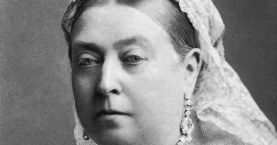
Queen Victoria (1819–1901) exhibited an interest in spiritualist phenomena, particularly following the death of her mother and her husband Prince Albert in 1861.
Early Interest
Queen Victoria showed an interest in psychic phenomena in the early years of her reign, before the emergence of Spiritualism in the 1850s.1 In 1846 she presented an engraved gold watch to Miss Georgiana Eagle ‘for her meritorious and extraordinary clairvoyance produced at Osborne House, Isle of Wight…’2 The watch eventually passed to WT Stead, then to the medium Etta Wriedt. It was later held at the premises of the London Spiritualist Alliance, from where it was stolen in the 1960s.3
Victoria entered an extended period of mourning following the death of her mother and husband in 1861. At this time she is said to have become interested in the possibility of making contact with deceased family members through spirit mediums. Learning from The Spiritualist magazine4 that Albert had spoken through the mediumship of a fourteen-year-old boy called ‘Jimmy’ Lees (Robert James Lees), she sent two trusted advisers to attend, anonymously, a séance, and following their report she sent for him. By this time she had also received from Lees an automatic script appearing to originate with the deceased Albert, which mentioned a pet name and other intimate details known only to the couple.5 Lees attended her on numerous occasions at Windsor and was rewarded with a pension from the royal estate.6
Questioned by researchers, Lees’s daughter Eva maintained that her father had not been a man to ‘indulge in ludicrous fabrication’7 and had been keen to keep his visits secret.8
John Brown
At Lees’s own recommendation, his role of maintaining contacts with Albert was eventually taken by someone in Victoria’s personal service. This was John Brown (1826-83), who had been born near Balmoral, a royal residence in Scotland, and entered service at the castle at the age of sixteen. He eventually worked officially as her gillie (attendant during outdoor pursuits), but unofficially he formed a strong relationship with her, possibly thanks to the Scottish forthrightness which she did not experience with her courtiers. From 1851 Brown habitually accompanied her outdoors. After the death of her husband, Victoria sent for to Brown to join her at Osborne House, and following an accident at Balmoral in which her carriage overturned, he became a constant companion. The bond was a source of uneasiness among her court and political advisers.9
Brown is said to have been involved in séances with Victoria, but the evidence for this is insecure. After Brown’s death the Queen sent a manuscript to Sir Henry Ponsonby mentioning that she intended to write a ‘memoir’ or biography of Brown, but Ponsonby impounded the documents and persuaded her to have them destroyed.10 In 1957 Hannen Swaffer, a Spiritualist journalist, wrote that he had been told by Lionel Logue, a confidant of King George VI, that one such diary had survived which was ‘very, very interesting’.11 Until these diaries or entries come to light, the case of her psychic activities with Brown remain unproven.
However, there is evidence that Victoria continued to hold an active interest in spirit mediumship later in her life. She is said to have arranged a meeting with William Stainton Moses at Balmoral in 1882 and expressed interest in descriptions told to her by Napoleon III of his personal experience of DD Home’s ‘remarkable powers’.12
Melvyn Willin
Literature
Barham, A. (1984). Strange to Relate. Gerrards Cross: Colin Smythe.
Brennan, J.H. (2013). Whisperers. New York: Overlook Duckworth.
Dale, J. (1986). The Prince and the Paranormal. London: Guild Publishing.
Longford, E. (1964). Victoria R.I. London: Weidenfeld and Nicolson.
Swaffer, H. (1957). The People, 5 May, 1957.
Tisdall, E.E.P. (1938). Queen Victoria’s John Brown. London: Stanley Cole & Co. Ltd.
Underwood, P. (1986). Queen Victoria’s Other World. London: Harrap.
West, D.J. (1949). The identity of ‘Jack the Ripper’. Journal of the Society for Psychical Research 35, 76-80.
Endnotes
- 1. Longford (1964).
- 2. Underwood (1986), 106-7.
- 3. Dale (1986), 125.
- 4. Barham (1984), 69.
- 5. Brennan (2013), 207.
- 6. Cited in West (1949), 77.
- 7. Cited in Dale (1986), 131.
- 8. Tisdall (1938), 118.
- 9. Tisdall (1938), 13.
- 10. Underwood (1986), 118.
- 11. Swaffer (1957). Cited in Dale (1986), 132.
- 12. Cited in Underwood (1986), 135.

